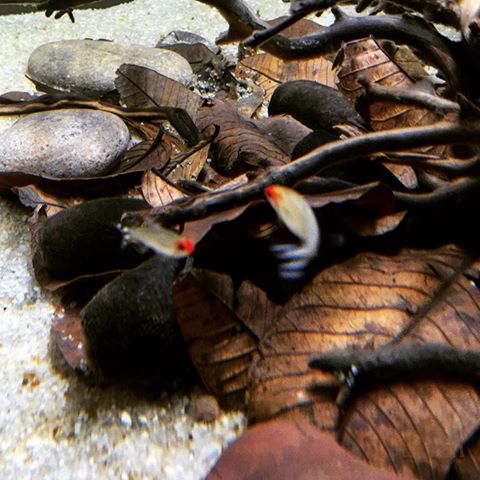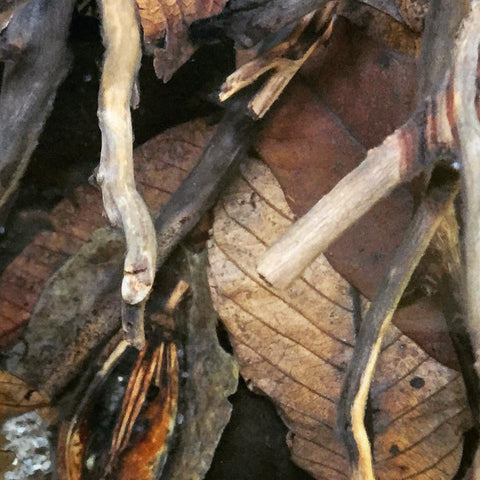- Continue Shopping
- Your Cart is Empty
A somewhat predictable path towards an exciting future.
When you embark on this new and earthy-looking path of adding leaves, seed pods, and other botanicals into your aquarium, which we've half-jokingly called a "New Botanical"-type of aquarium, you're probably curious as to what to expect as your aquarium progresses from it's startup phase, through its maturity, and ultimately into a stable, established system.

Interestingly, after setting up quite a few tanks in this fashion, I've found that they appear to follow an almost predictable progression as they evolve. I've noticed some definite "phases" that they go through, which provides us a "measuring stick" with which to track the progress and condition of the aquarium.
The progression and phases goes something like this:
Startup- You add your properly-prepared botanicals and leaves gradually, so as not to overwhelm your newly-established bacteria population as they establish the biological filtration for your aquarium. Depending upon which items you've added to your system (i.e.; really "reactive" botanicals, such as leaves, coco curls, Alder Cones, wood, some of the softer seed pods, etc.) your water may start turning a golden-brown color. Like any other startup, you're advised to monitor ammonia, nitrite, pH, and eventually, nitrate.
After a couple of weeks, the tank should have completed its initial cycling, and your botanicals have settled in, with some, such as the Catappa and Guava leaves, beginning to soften up a bit. The water will have darkened a bit more, and the tank will have distinctive earthy scent. If all of the parameters are stable, it's time to begin gradually stocking your aquarium with fishes!

"Biofilm Phase"- Typically, after 2-3 weeks, some of your botanicals will "recruit" various fungi and biofilms on their surfaces, which is typical of what happens in nature. These biofilms may be offensive to look at, but they're perfectly natural, and usually a good sign of biological activity in the aquarium! It happens in nature- these are present in natural habitats, such as leaf litter zones, etc. continuously. I've written about this before. It's not fun for a lot of hobbyists to experience this, especially if you've never had a tank with brown water, leaves, and other materials. Oh, and it's easy to want to get discouraged, but you need to remind yourself that this is not like other aquariums you've created in the past.
Typically, this is a phase, with most systems evolving past the heavy growth of biofilms after a few more weeks. There will always be some present in a botanically-influenced system. It's a mental leap that we as aquarists have to understand accept for this type of aquarium. Sure, you can regularly scrape and siphon these materials way, and they may or may not come back for a while.
I remember when I first started experimenting with "New Botanical"-style tanks, and how I would get discouraged, frustrated, and dissillusioned, until I did some research and realized that this biofilm was not a bad thing, and that many fishes and other animals actually benefitted from it! In fact, Caridina and Neocaridina shrimps, for example, LOVE this stuff, and a healthy population could help to serve as a biological control to keep biofilms in check. The old "Wen life gives you lemons..." mindset. It's true!

Remember to keep up with your regular maintenance, such as water changes, filter media replacement, etc., as these are necessary in any healthy aquarium; particularly so in a system with a bioload of botanical material, especially in the earlier phases of the aquarium's existence, as beneficial bacterial populations are growing to meet the ever-increasing demands of the expanding fish population!

Algal films and stringy algae are also part of this phase. Much has been written about how to deal with them. Some is a function of nutrient availability, export, and control. Much of these algae will dissipate naturally once the aquarium has "sorted itself out", but you will always see some algae in this type of system- just like in nature. It's a beneficial, natural part of the microcosm you've created.
"Maturity Phase"- At this point, a few months in, your aquarium is on a kind of "roll", if you will: A lot of the initial bursts of tannins and organics that may have resulted in massive amounts of biofilms and even algae, are done.The fish population is more stable, with additions of new fishes less frequent (well, for some of you, lol). The aquarium is starting to settle in to a rhythm of sorts, enhanced by your regular attention to maintenance. Remember, many of the leaves will need to be replaced as they decompose, if you want to maintain the leaf litter "aesthetic" that you started with. Some of the seed pods may or may not need to be replaced; do what you feel makes the most sense for you.
You'll notice things that perhaps you haven't before: Different behaviors by fishes you perhaps have not seen, such as the forging activities they engage in among the leaves and botanicals. I remember seeing my Nannostomus beckfordi Pencilfish "pecking" at the pods and wood in their tank, hunting for microorganisms and such, just like in nature. it was pretty satisfying to see!
You'll also notice colors and overall health of many of your fishes that are accustomed to blackwater environments is noticeably better. They look robust, calm, relaxed. Part of this is attributable to your good overall husbandry. And I suspect a good part of this is also attributable to the aforementioned benefits of this type of environment. By "staying with it" and understanding what is going on during the initial phases of your aquarium's life cycle, you'll be able to make that "mental shift" to a different kind of aquarium. Study, enjoy...remain calm and objective.
Never make knee-jerk "panic decisions" and take extraordinary measures to "correct" what appear to be "problems" in the system. It pays to reevaluate and analyize just what made these "problems" arise in the first place, so you can decide what, if any- action you SHOULD take. Don't freak out about biofilms and such that you see from using large quantities of aquatic botanicals in the system from the outset. It's natural, and if your water quality tests indicate everything is okay, accept that! This is not an invitation to employ "relaxed" husbandry. Rather, it's an acknowledgment that you're required to understand what is "normal" for your aquarium.
You may not like it. You may simply tell yourself that decomposing leaves, biofilms, and brown water are too much to look at every day. The aesthetic may not be for you. You may not like the maintenance involved (siphoning debris as necessary, adding new leaves and botanicals regularly to replace decomposed ones, etc.). You may simply yearn for clear water and green plants.

And that's okay.
The beauty of this hobby is that there are all types of methodologies. An endless array of aesthetic choices. A huge variety of fishes.

The "New Botanical"-style aquarium is just one. Not the best way. Not the easiest way.
Just a different one.
Enjoy it.
Stay open-minded. Stay curious. Stay enthusiastic.
And Stay Wet.
Scott Fellman
Tannin Aquatics















Scott Fellman
Author